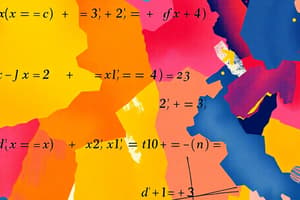Podcast
Questions and Answers
What is a key objective in establishing an optimal separating hyperplane?
What is a key objective in establishing an optimal separating hyperplane?
- Maximizing the distance between the hyperplane and the nearest data points (correct)
- Ensuring all data points are correctly classified
- Minimizing the number of data points
- Decreasing computational complexity
In the context of non-separable data, what is the purpose of using a soft margin?
In the context of non-separable data, what is the purpose of using a soft margin?
- To ensure no data points touch the margin
- To allow some margin violations while still optimizing the hyperplane (correct)
- To eliminate the need for optimization
- To classify all points correctly without errors
What mathematical concept is primarily used to gauge the performance of a model in margin-based classifiers?
What mathematical concept is primarily used to gauge the performance of a model in margin-based classifiers?
- Absolute Loss
- Hinge Loss (correct)
- Logistic Loss
- Quadratic Loss
Which statement about maximizing margin in machine learning is accurate?
Which statement about maximizing margin in machine learning is accurate?
What is an inherent challenge of creating a separating hyperplane for non-separable data?
What is an inherent challenge of creating a separating hyperplane for non-separable data?
Flashcards
Separating Hyperplane
Separating Hyperplane
A line or hyperplane that perfectly separates two classes of data points in a multidimensional space, with no overlapping points.
Optimal Separating Hyperplane
Optimal Separating Hyperplane
The separating hyperplane that maximizes the distance between the closest points of each class. It creates the largest possible margin for error.
Margin
Margin
The distance between the optimal separating hyperplane and the closest data points of each class.
Soft Margin
Soft Margin
Signup and view all the flashcards
Hinge Loss
Hinge Loss
Signup and view all the flashcards
Study Notes
Machine Learning - EEC3501
- The lecture introduces the concept of a linear classifier that distinguishes between two classes of data points.
- Data points are represented graphically with stars and circles.
- A linear decision boundary is needed to separate the classes effectively.
- The decision boundary (hyperplane) is a line in 2D space, but generally for a higher-dimensional space, it's a hyperplane with one less dimension.
- The equation for a hyperplane is f(x) = wTx + b = 0, where x is a data point, w is a vector parameter, and b is a bias parameter.
- An optimal hyperplane seeks to maximize the distance to the nearest data point in either class, a maximum margin.
- The distance, margin, calculation involves the closest point from either class.
- Ensuring a classifier is not too close to data points leads to better generalization for the test data.
- The decision hyperplane (in the 2D case, a line) is perpendicular to w.
- A unit vector, w*, is defined in the same direction as w for geometric definition.
- The correct classification of data point (x(i)) is denoted by sign(wTx(i) + b) = t(i).
- Classification can be rewritten as t(i)(wTx(i) + b) > 0.
- A suitable margin of C ensures data points are correctly separated.
- The aim is to find the maximum margin, hence minimizing ||w||2, with the constraint t(i)(wTx(i) + b) ≥ 1 for each data point i.
- Training points with algebraic margins of 1 are called Support Vectors.
- If data are not linearly separable, slack variables ξi can be introduced to allow data points to be within or beyond the margin.
- An algebraic constraint is used t(i)(wTx(i) + b) ≥ 1−ξi, and the total sum of ξi must be penalized, i.e., minimized.
- The hyperparameter γ controls the trade-off between maximizing the margin and managing errors.
- The hinge loss function is introduced; it has the form Lhinge (y, t) = (1-ty).
- This function helps determine how well the hyperplane fits the data.
- Soft-margin SVM is a linear classifier with hinge loss function and L2 regularization term.
Studying That Suits You
Use AI to generate personalized quizzes and flashcards to suit your learning preferences.




